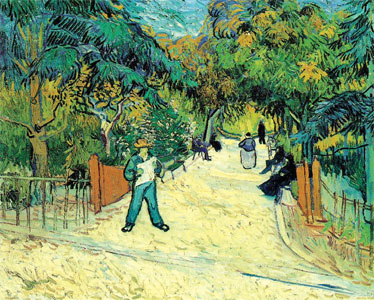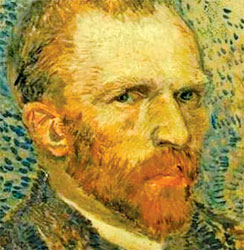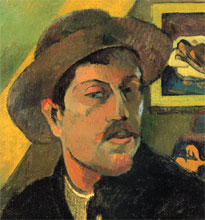Impressionist period
Provence and Paris, 1870-1878:
[Vincent Van Gogh]
  The son of a pastor, brought up in a religious and cultured
atmosphere, Vincent was highly emotional and lacked self-confidence.
Between 1860 and 1880, when he finally decided to become an artist, Van
Gogh had had two unsuitable and unhappy romances and had worked
unsuccessfully as a clerk in a bookstore, an art salesman, and a
preacher in the Borinage (a dreary mining district in Belgium), where he
was dismissed for overzealousness. The son of a pastor, brought up in a religious and cultured
atmosphere, Vincent was highly emotional and lacked self-confidence.
Between 1860 and 1880, when he finally decided to become an artist, Van
Gogh had had two unsuitable and unhappy romances and had worked
unsuccessfully as a clerk in a bookstore, an art salesman, and a
preacher in the Borinage (a dreary mining district in Belgium), where he
was dismissed for overzealousness.
He remained in Belgium to study art, determined to give happiness by
creating beauty. The works of his early Dutch period are sombre-toned,
sharply lit, genre paintings of which the most famous is "The Potato
Eaters" (1885). In that year van Gogh went to Antwerp where he
discovered the works of Rubens and purchased many Japanese prints.
In 1886 he went to Paris to join his brother Théo, the manager of
Goupil's gallery.
In Paris, van Gogh studied with Cormon, inevitably met Pissarro,
Monet, and Gauguin, and began to lighten his very dark palette and to
paint in the short brushstrokes of the Impressionists.
[Georges Seurat]
  Painter, founder of the 19th-century French school of
Neo-Impressionism whose technique for portraying the play of light using
tiny brushstrokes of contrasting colours became known as Pointillism.
Using this techique, he created huge compositions with tiny, detached
strokes of pure colour too small to be distinguished when looking at the
entire work but making his paintings shimmer with brilliance. Works in
this style include Une Baignade (1883-84) and Un dimanche après-midi à
l'Ile de la Grande Jatte (1884-86). Painter, founder of the 19th-century French school of
Neo-Impressionism whose technique for portraying the play of light using
tiny brushstrokes of contrasting colours became known as Pointillism.
Using this techique, he created huge compositions with tiny, detached
strokes of pure colour too small to be distinguished when looking at the
entire work but making his paintings shimmer with brilliance. Works in
this style include Une Baignade (1883-84) and Un dimanche après-midi à
l'Ile de la Grande Jatte (1884-86).
A French painter who was a leader in the neo-impressionist movement
of the late 19th century, Georges Seurat is the ultimate example of the
artist as scientist. He spent his life studying color theories and the
effects of different linear structures.
His 500 drawings alone establish Seurat as a great master, but he
will be remembered for his technique called pointillism, or divisionism,
which uses small dots or strokes of contrasting color to create subtle
changes in form. Georges-Pierre Seurat was born on Dec. 2, 1859, in
Paris. He studied at the Ecole des Beaux-Arts in 1878 and 1879. His
teacher was a disciple of Jean-Auguste-Dominique Ingres. Young Seurat
was strongly influenced by Rembrandt and Francisco de Goya.
[Paul Cézanne ]
  Camille Pissarro lived in Pontoise. There and in Auvers he and
Cézanne painted landscapes together. For a long time afterwards, Cézanne
described himself as Pissarro's pupil, referring to him as "God the
Father", as well as saying: "We all stem from Pissarro." Under
Pissarro's influence Cézanne began to abandon dark colours and his
canvases grew much brighter Camille Pissarro lived in Pontoise. There and in Auvers he and
Cézanne painted landscapes together. For a long time afterwards, Cézanne
described himself as Pissarro's pupil, referring to him as "God the
Father", as well as saying: "We all stem from Pissarro." Under
Pissarro's influence Cézanne began to abandon dark colours and his
canvases grew much brighter
Leaving Hortense in the Marseille region, Cézanne moved between Paris
and Provence, exhibiting in the first (1874) and third Impressionist
shows (1877). In 1875, he attracted the attention of the collector
Victor Chocquet, whose commissions provided some financial relief.
But Cézanne's exhibited paintings attracted hilarity, outrage, and
sarcasm. Reviewer Louis Leroy said of Cézanne's portrait of Chocquet:
"This peculiar looking head, the colour of an old boot might give [a
pregnant woman] a shock and cause yellow fever in the fruit of her womb
before its entry into the world."
Cézanne stabilised his residence in L'Estaque. He painted with Renoir
there in 1882 and visited Renoir and Monet in 1883 Mature period,
Provence, 1878-1890 Mont Sainte-Victoire (c. 1887), Courtauld Institute
of Art Jas de Bouffan, 1885-1887.
His paintings became well-known and sought after and he was the
object of respect from a new generation of painters. In 1891 he turned
to Catholicism. Cézanne alternated between painting at Jas de Bouffan
and in the Paris region, as before. In 1895 he made a germinal visit to
Bibémus Quarr.
[Paul Gauguin]
  Famed French artist Paul Gauguin, born in Paris on June 7, 1848,
created his own unique painting style, much like he crafted his own
distinctive path through life. Known for bold colors, simplified forms
and strong lines, he didn't have any art formal training. Gauguin
instead followed his own vision, abandoning both his family and artistic
conventions. Famed French artist Paul Gauguin, born in Paris on June 7, 1848,
created his own unique painting style, much like he crafted his own
distinctive path through life. Known for bold colors, simplified forms
and strong lines, he didn't have any art formal training. Gauguin
instead followed his own vision, abandoning both his family and artistic
conventions.
Gauguin began painting in his spare time, but quickly became serious
about his hobby. One of his works was accepted into the "Salon of 1876,"
an important art show in Paris. Gauguin met artist Camille Pissarro
around this time, and his work attracted the interest of the
Impressionists.
The Impressionists were a group of revolutionary artists who
challenged traditional methods and subjects, and had been largely
rejected by the French art establishment. Gauguin was invited to show at
the group's fourth exhibition in 1879, and his work appeared among the
works of Pissarro, Edgar Degas, Claude Monet and other artistic greats.
By 1883, Gauguin had stopped working as a stockbroker so that he could
fully devote himself to his art. In 1888, Gauguin created one of his
most famous paintings, "Vision of the Sermon." The boldly coloured work
showed the Biblical tale of Jacob wrestling with the angel.
-Internet |

